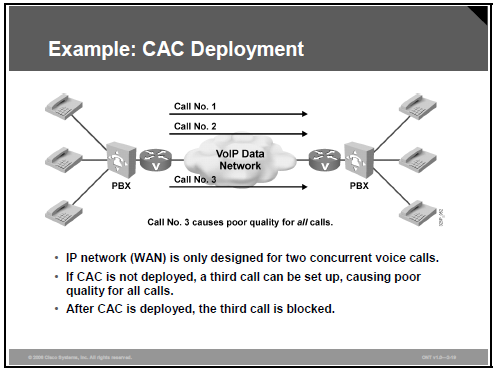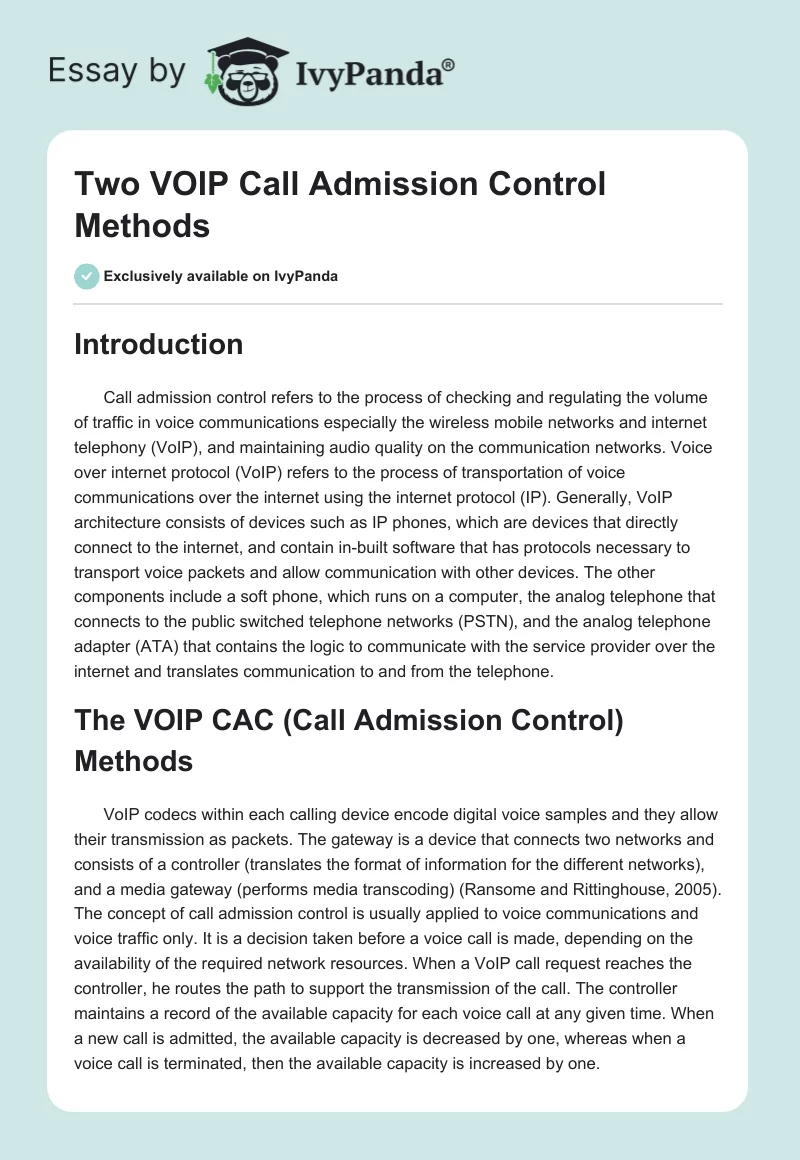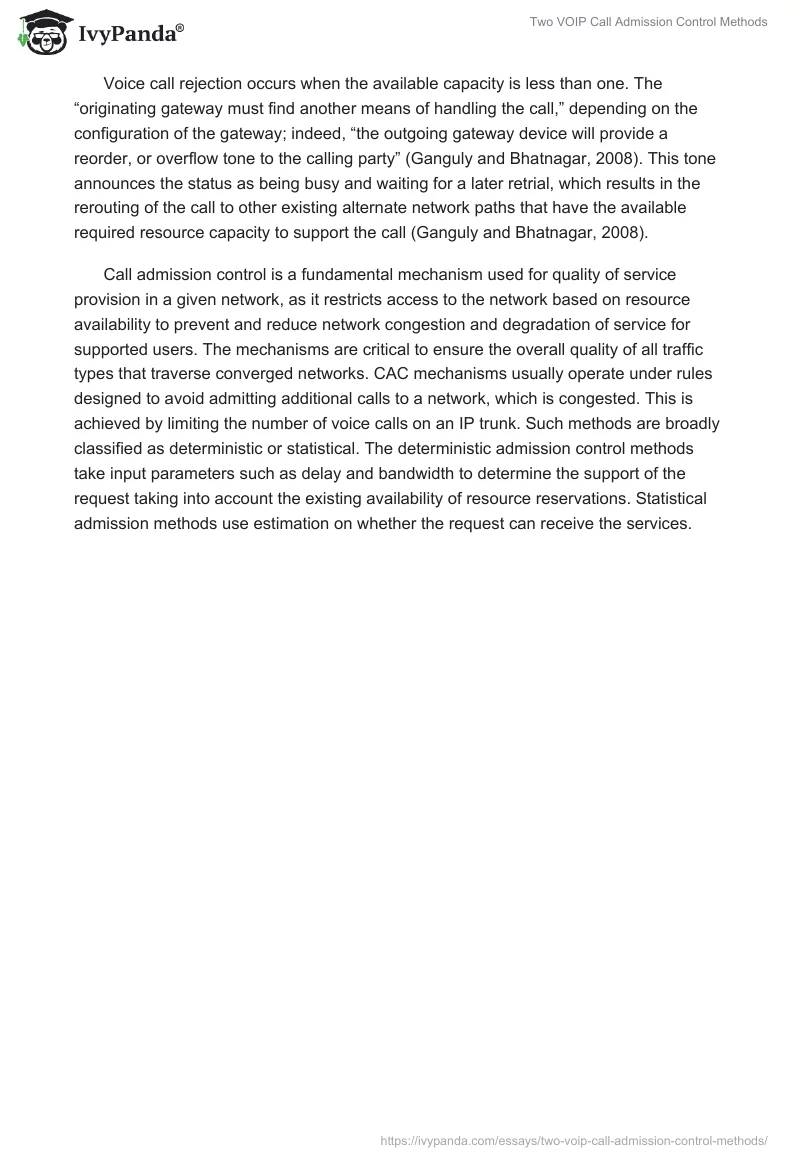Introduction
Call admission control refers to the process of checking and regulating the volume of traffic in voice communications especially the wireless mobile networks and internet telephony (VoIP), and maintaining audio quality on the communication networks. Voice over internet protocol (VoIP) refers to the process of transportation of voice communications over the internet using the internet protocol (IP). Generally, VoIP architecture consists of devices such as IP phones, which are devices that directly connect to the internet, and contain in-built software that has protocols necessary to transport voice packets and allow communication with other devices. The other components include a soft phone, which runs on a computer, the analog telephone that connects to the public switched telephone networks (PSTN), and the analog telephone adapter (ATA) that contains the logic to communicate with the service provider over the internet and translates communication to and from the telephone.
The VOIP CAC (Call Admission Control) Methods
VoIP codecs within each calling device encode digital voice samples and they allow their transmission as packets. The gateway is a device that connects two networks and consists of a controller (translates the format of information for the different networks), and a media gateway (performs media transcoding) (Ransome and Rittinghouse, 2005). The concept of call admission control is usually applied to voice communications and voice traffic only. It is a decision taken before a voice call is made, depending on the availability of the required network resources. When a VoIP call request reaches the controller, he routes the path to support the transmission of the call. The controller maintains a record of the available capacity for each voice call at any given time. When a new call is admitted, the available capacity is decreased by one, whereas when a voice call is terminated, then the available capacity is increased by one.
Voice call rejection occurs when the available capacity is less than one. The “originating gateway must find another means of handling the call,” depending on the configuration of the gateway; indeed, “the outgoing gateway device will provide a reorder, or overflow tone to the calling party” (Ganguly and Bhatnagar, 2008). This tone announces the status as being busy and waiting for a later retrial, which results in the rerouting of the call to other existing alternate network paths that have the available required resource capacity to support the call (Ganguly and Bhatnagar, 2008).
Call admission control is a fundamental mechanism used for quality of service provision in a given network, as it restricts access to the network based on resource availability to prevent and reduce network congestion and degradation of service for supported users. The mechanisms are critical to ensure the overall quality of all traffic types that traverse converged networks. CAC mechanisms usually operate under rules designed to avoid admitting additional calls to a network, which is congested. This is achieved by limiting the number of voice calls on an IP trunk. Such methods are broadly classified as deterministic or statistical. The deterministic admission control methods take input parameters such as delay and bandwidth to determine the support of the request taking into account the existing availability of resource reservations. Statistical admission methods use estimation on whether the request can receive the services.

The above figure shows CAC deployment over the VoIP network, which is designed to allow two concurrent calls to be placed across the VoIP network. The third call, if allowed, would cause latency and poor quality that will affect all the calls on the network. The private branch exchange (PBX) is a telephone serving a particular office or business.
The VoIP control admission methods are usually based on the following mechanisms that allow processing of the call within the entire VoIP network that contains a call admission control.
Measurement-based CAC
These mechanisms use probes to measure the delay and loss of packets. This method allows each connection to reserve its peak bandwidth when the connection is established, as well as propagating the initiation of a new call. In addition, this mechanism plays a significant role in availing resources necessary for the effectiveness of the VoIP session. This is achieved by “preventing calls arriving from the IP network from entering the gateway when required resources are not available to process the call” (Ganguly and Bhatnagar, 2008). The device usually obtains such information through probing on IP, with the sent probes returning measured information, which provides a detailed description of the overall conditions prevailing through the network.
The outgoing device combines the returned information with the configuration information of the device to determine whether the conditions of the network exceed the configured threshold. If the threshold is not exceeded, the calls are processed and sent across the network, whereas when the threshold is exceeded, the call is dropped, or queued and processed only when the resources are available and within the threshold described. The advantage of this method is the fact that “when detecting network congestion, the public switched telephone network (PSTN) fallback feature does not affect an existing call, but rather affects only the subsequent call” (Ganguly and Bhatnagar, 2008).
Resource-based CAC
Two types of the above mechanism exist; the resources in this context include those that are local to the router such as CPU and memory, or they can be network resources, such as link bandwidth. DSP availability and DSO time slots on the connecting TDM trunks to a voice device before admitting a new call are essential, as several of these resources could be constrained at the nodes or multiple nodes that the call usually traverses on its way to its destination. Configuration is based on local system resources when using SIP gateways using the call threshold and call treatment commands. The number of the public switched telephone network (PSTN) calls that a router receives within a configurable time can be limited using the call spike global command. The reservation mechanisms guarantee the quality of service for the duration of the call. All the calculation of resource availability is performed on the gateway device, to allow, reject, or redirect the incoming call to other existing networks.
All the above methods are applied to ensure that the quality of service required is maintained across the VoIP network. With the adoption and use of call admission control within the network, latency and quality of calls are reduced without compromising the quality of subsequent calls that the network can support concurrently.
References
Ganguly, S. and Bhatnagar, S. (2008). VoIP: wireless, P2P and New Enterprise Voice over IP. West Sussex: John Wiley and Sons. Web.
Ransome, F, J. and Rittinghouse, W, J. (2005). VoIP security. Burlington: Elsevier Digital Press. Web.


